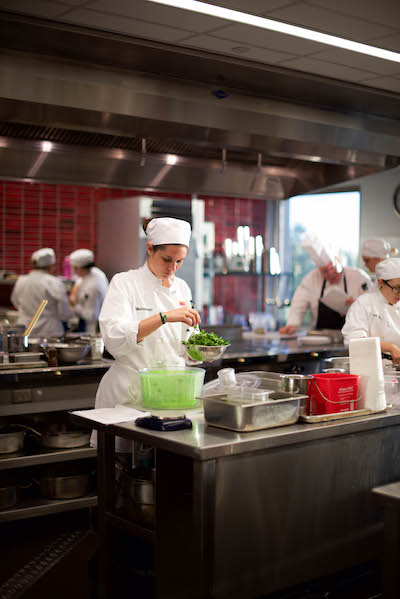Going to culinary school is an exciting journey that can kickstart your career in the kitchen, so here are a couple of tips to help you get started.
As a new student at ICE, it's OK to have never cooked in a professional kitchen before and to not know everything — that's why you're coming to school in the first place. When you come to culinary school, you'll have the opportunity to develop your skillset in professionally designed kitchens and set yourself up for future success. But, coming into any new situation can be nerve-wracking, so we put together some tips and terms to know before you begin your culinary journey.
Test Your Technique
ICE offers different career programs to fit your specific interests: the Culinary Arts program for people interested in the savory side of the kitchen; the Pastry & Baking program for the sweet side; and Health-Supportive Culinary Arts for those interested in studying sustainability and plant-based cooking.
You’ll practice a range of professional techniques in all of these programs at ICE's New York and Los Angeles campuses. These are skills that all chefs develop overtime, so understanding what they are before you even come to school will help you feel prepared and ready to get cooking.
- Clean as you cook: This is one of the most important kitchen skills to have. Keeping a clean station is stressed in both the classroom and restaurant kitchens, so getting into the habit of being neat will prepare you for your professional career.
- Use the metric system: Culinary math is probably a bit different than what you're used to, as units are typically codified into the metric system in the classroom and professional kitchens. Understanding the differences between ounces, liters, grams and so on, will make it easier to get cooking.
- Visualize and write out the steps of a recipe before you start cooking: Writing out the steps of a recipe is a good way to study and truly understand what you're working on. Just like doing your mise en place, running through a recipe in your head or on paper is an important step when preparing to cook.
And you can now practice all of these skills in your own home. ICE offers an online Culinary Arts & Food Operations, bringing curriculum designed by expert chefs to your home kitchen.
See how ICE's online culinary school works.
Know Your Kitchen Terms
Mise en place: Often just shortened to mise, this refers to all of the prepped ingredients that a chef will need in order to have a successful service. These ingredients are readily available for the chef to quickly prepare dishes.

Brigade: A system of hierarchy found in restaurants and hotels. The hierarchical structure can vary, depending on the kitchen. Some of the variations include:
- One executive chef and many line cooks
- One executive chef, one or more sous chefs and some line cooks
- One executive chef, one executive sous chef, one chef de cuisine per restaurant (and perhaps a sous chef for each chef de cuisine), a banquet chef and a pastry chef
Fire: When you hear this in the kitchen, that means it is time to start preparing a dish. Typically, orders are made when they are received, but sometimes they have to be delayed so each dish is timed to finish at the same time. If a table orders appetizers and entrees, the appetizers will be fired first.
Heard: If you’ve ever watched a cooking show before, you’ve, ahem, heard this term. This is shouted back at whoever calls out instructions to the kitchen to let them know that they have been understood.
Behind: This term is key to kitchen safety. Any time you are crossing behind someone in a kitchen, it must be said so that the person who is dealing with the hot pan or plate of food does not injure themselves or someone else. Similar terms include "sharp knife" and "hot behind."
Stage: Pronounced st-ah-j, this is the French term for shadowing in another chef's kitchen, with the goal of learning new techniques and developing your repertoire.
"Yes, Chef!": Say this in response to the head chef of the kitchen. This is to let the chef know that you have heard them and understood their message. Although it is a sign of respect and is earned in kitchens worldwide, it is also a safety measure to ensure that the kitchen runs smoothly.
Mother Sauces: The five sauces that every chef should have in their repertoire, and each one can be transformed into its own family of different sauces. They include:
- Béchamel Sauce
- Velouté Sauce
- Espagnole Sauce
- Hollandaise Sauce
- Classic Tomate Sauce
Brush Up On Food Safety
This is an important lesson that you'll study early in your career program at ICE. Understanding how to properly store and handle food; cook meats to the right temperature; and safely use knives is critical to your success in the classroom and in your culinary career.
Before you study the ins and outs of food safety, here are a few key tips to remember:
- Perishable food should be kept below 45˚F or above 135˚F.
- Dairy or protein based foods should not be left at room temperature.
- Refrigerators should stay below 41˚F at all times.
This blog post was originally published by the International Culinary Center (ICC), founded as The French Culinary Institute (FCI). In 2020, ICE and ICC came together on one strong and dynamic national platform at ICE's campuses in New York City and Los Angeles. Explore your culinary education where the legacy lives on.




